Overclockable Pentium Anniversary Edition Review: The Intel Pentium G3258
by Ian Cutress on July 14, 2014 10:00 AM EST- Posted in
- CPUs
- Intel
- Pentium
- Overclocking
- Pentium-AE
- G3258
CPU Benchmarks
The dynamics of CPU Turbo modes, both Intel and AMD, can cause concern during environments with a variable threaded workload. There is also an added issue of the motherboard remaining consistent, depending on how the motherboard manufacturer wants to add in their own boosting technologies over the ones that Intel would prefer they used. In order to remain consistent, we implement an OS-level unique high performance mode on all the CPUs we test which should override any motherboard manufacturer performance mode.
HandBrake, SD Film: link
For HandBrake, we take two videos (a 2h20 640x266 DVD rip and a 10min double UHD 3840x4320 animation short) and convert them to x264 format in an MP4 container. Results are given in terms of the frames per second processed, and HandBrake uses as many threads as possible.
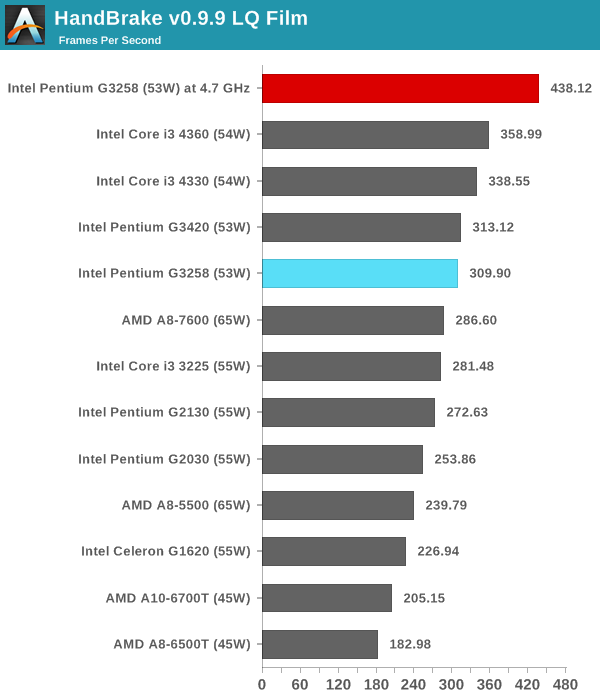
For low quality encoding, single threaded performance wins out over threads despite the extra multi-threading of i3 processors.
HandBrake, 4K60 Animation: link
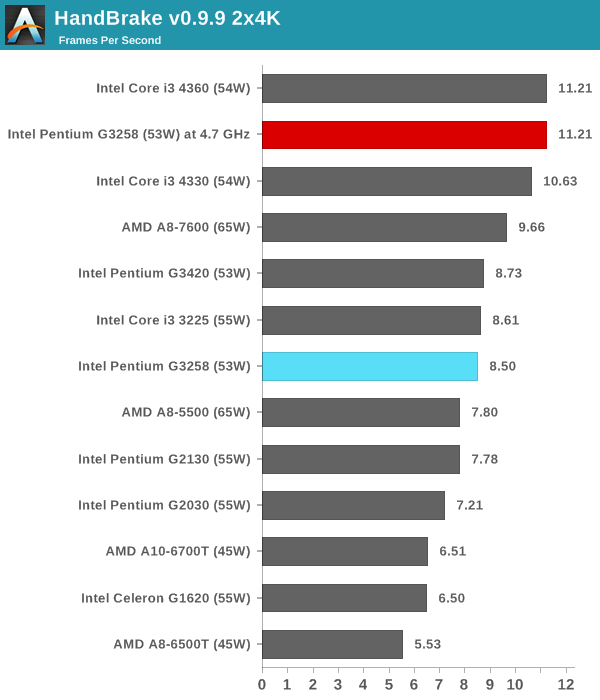
For larger frame sizes, the extra MHz of the overclock brings it on par with the i3-4360, although one might suggest spending the extra $40 for the i3 to ensure full stability.
Agisoft Photoscan – 2D to 3D Image Manipulation: link
Agisoft Photoscan creates 3D models from 2D images, a process which is very computationally expensive. The algorithm is split into four distinct phases, and different phases of the model reconstruction require either fast memory, fast IPC, more cores, or even OpenCL compute devices to hand. Agisoft supplied us with a special version of the software to script the process, where we take 50 images of a stately home and convert it into a medium quality model. This benchmark typically takes around 15-20 minutes on a high end PC on the CPU alone, with GPUs reducing the time.
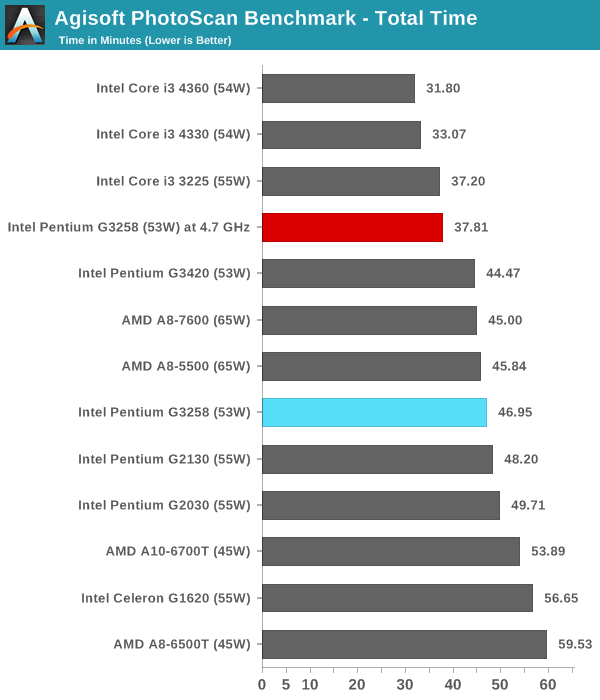
Dolphin Benchmark: link
Many emulators are often bound by single thread CPU performance, and general reports tended to suggest that Haswell provided a significant boost to emulator performance. This benchmark runs a Wii program that raytraces a complex 3D scene inside the Dolphin Wii emulator. Performance on this benchmark is a good proxy of the speed of Dolphin CPU emulation, which is an intensive single core task using most aspects of a CPU. Results are given in minutes, where the Wii itself scores 17.53 minutes.
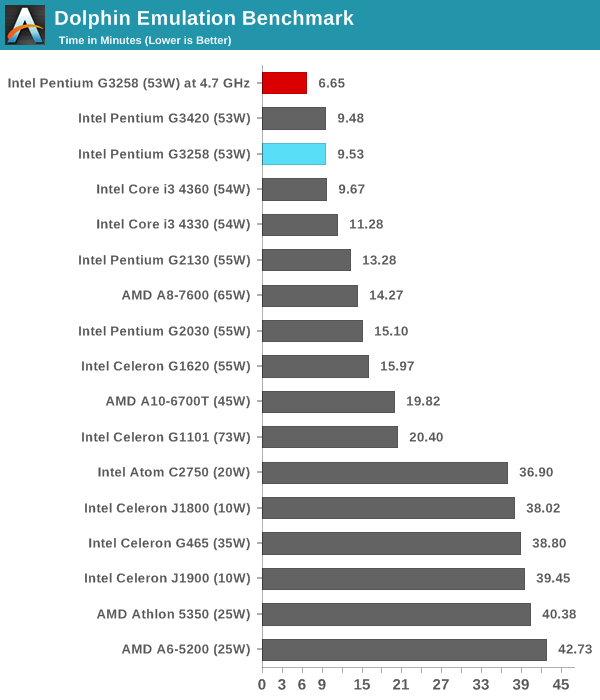
Dolphin is another example where Haswell combined with strong single threaded performance wins.
WinRAR 5.0.1: link
This test compresses a set of 2867 files across 320 folders totaling 1.52 GB in size – 95% of these files are small typical website files, and the rest (90% of the size) are small 30 second 720p videos.
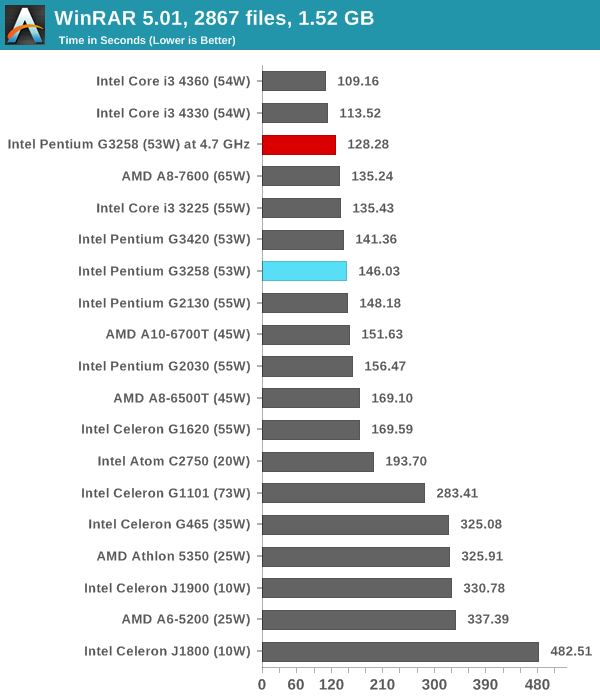
PCMark8 v2 OpenCL on IGP
A new addition to our CPU testing suite is PCMark8 v2, where we test the Work 2.0 and Creative 3.0 suites in OpenCL mode. As this test is new, we have not run it on many AMD systems yet and will do so as soon as we can.
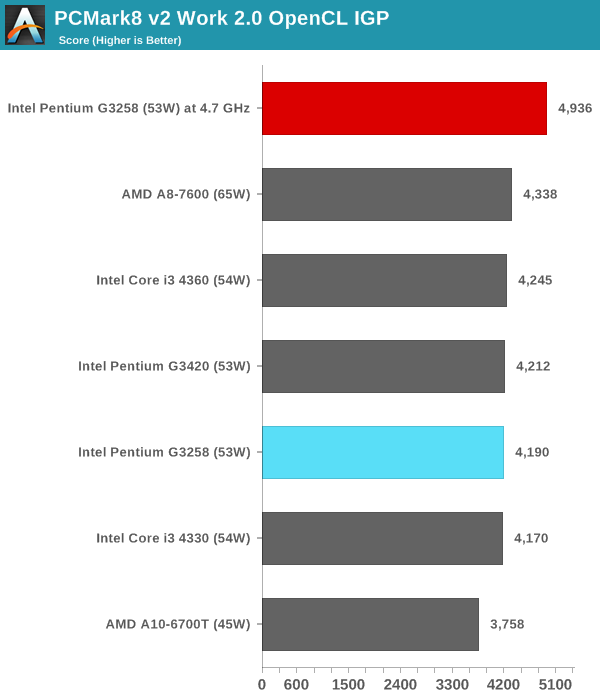
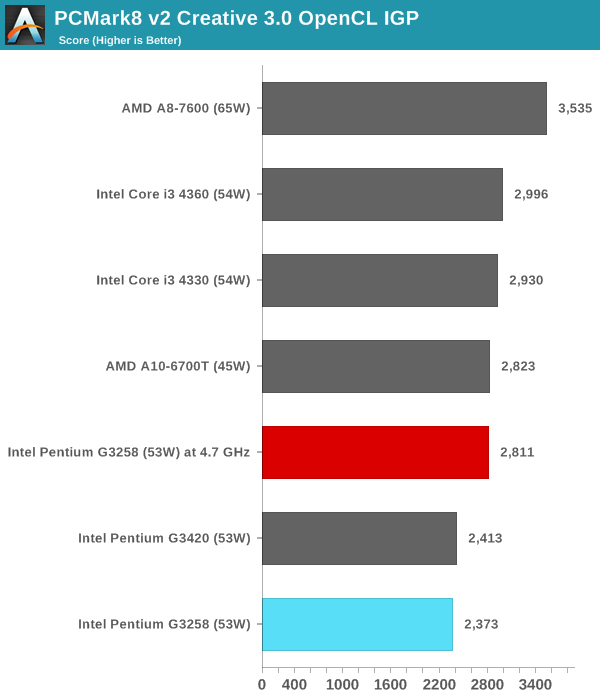
In both of our PCMark8 v2 results, overclocking the CPU gave a significant jump in performance. This would be down to the single threaded nature of parts of the benchmark, allowing web browsing and the snappyness of the system to be sped up.
Hybrid x265
Hybrid is a new benchmark, where we take a 4K 1500 frame video and convert it into an x265 format without audio. Results are given in frames per second.
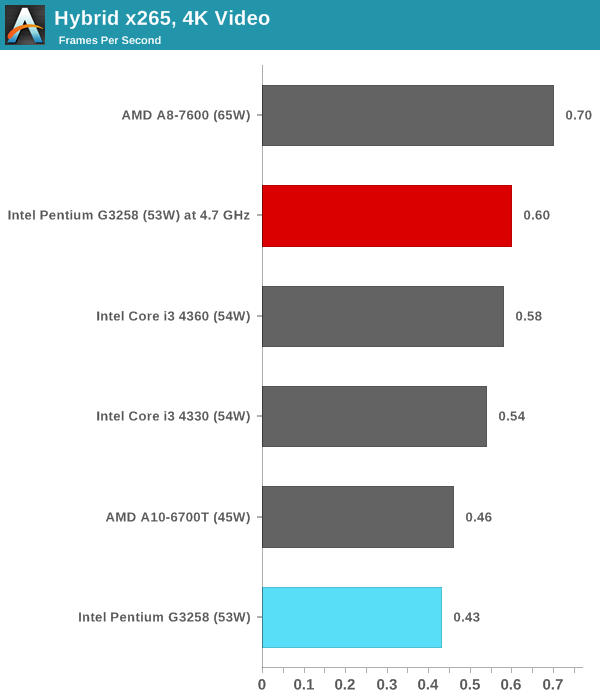
Almost an extra 50% performance for Hybrid x265 encoding.
Cinebench R15
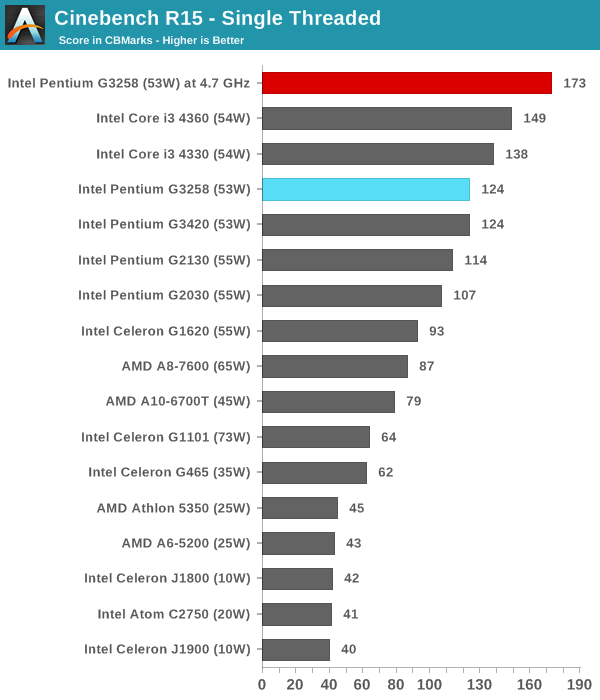
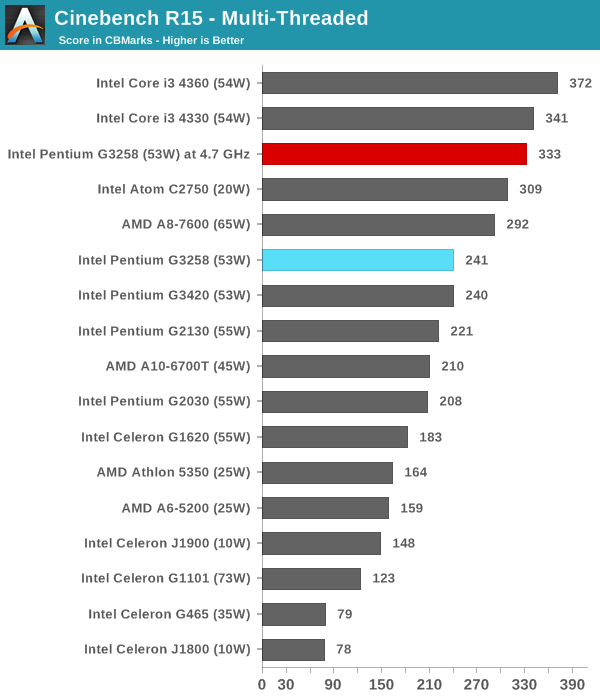
3D Particle Movement
3DPM is a self-penned benchmark, taking basic 3D movement algorithms used in Brownian Motion simulations and testing them for speed. High floating point performance, MHz and IPC wins in the single thread version, whereas the multithread version has to handle the threads and loves more cores.

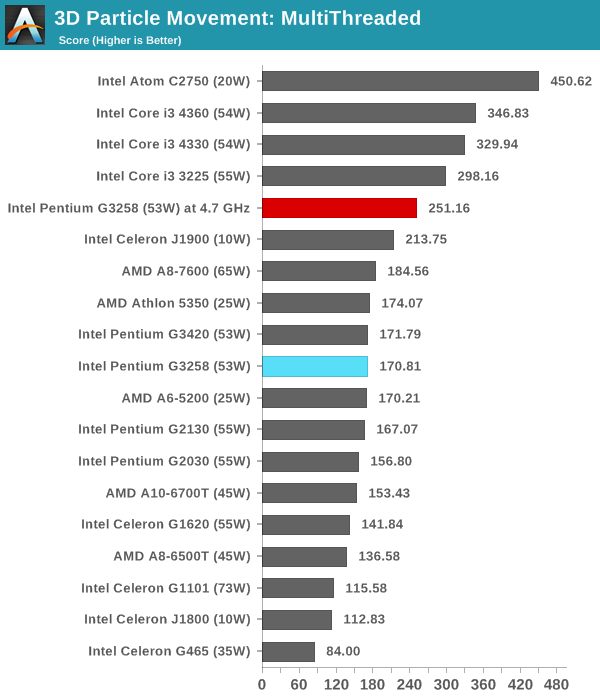
FastStone Image Viewer 4.9
FastStone is the program I use to perform quick or bulk actions on images, such as resizing, adjusting for color and cropping. In our test we take a series of 170 images in various sizes and formats and convert them all into 640x480 .gif files, maintaining the aspect ratio. FastStone does not use multithreading for this test, and results are given in seconds.
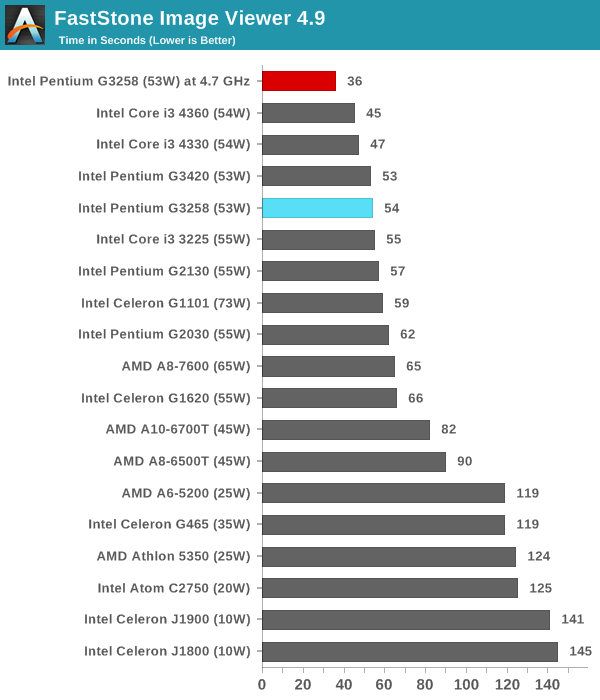
Web Benchmarks
On the lower end processors, general usability is a big factor of experience, especially as we move into the HTML5 era of web browsing. For our web benchmarks, we take four well known tests with Chrome 35 as a consistent browser.
Sunspider 1.0.2
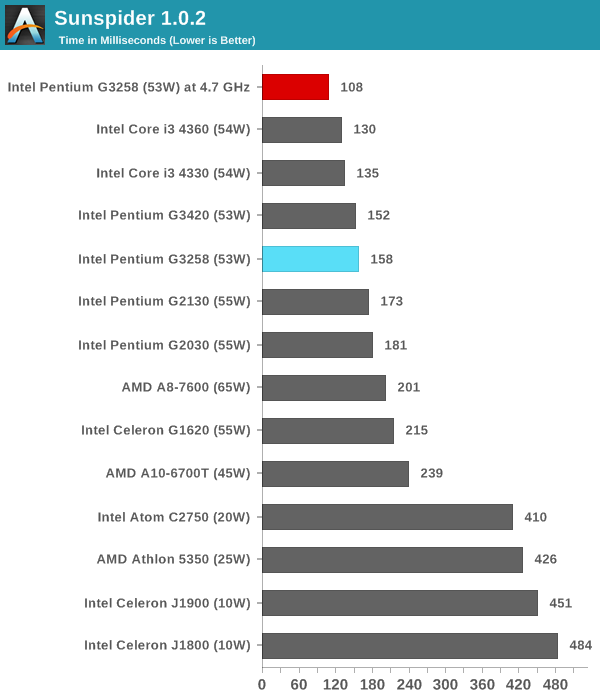
Mozilla Kraken 1.1
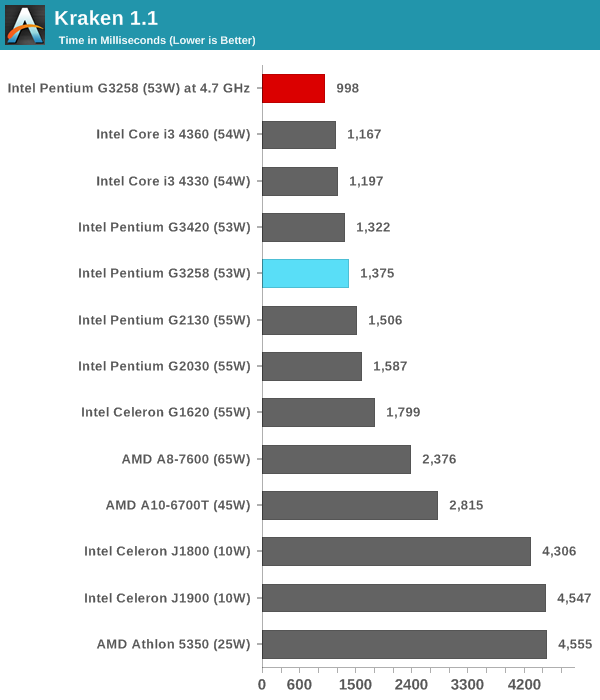
WebXPRT
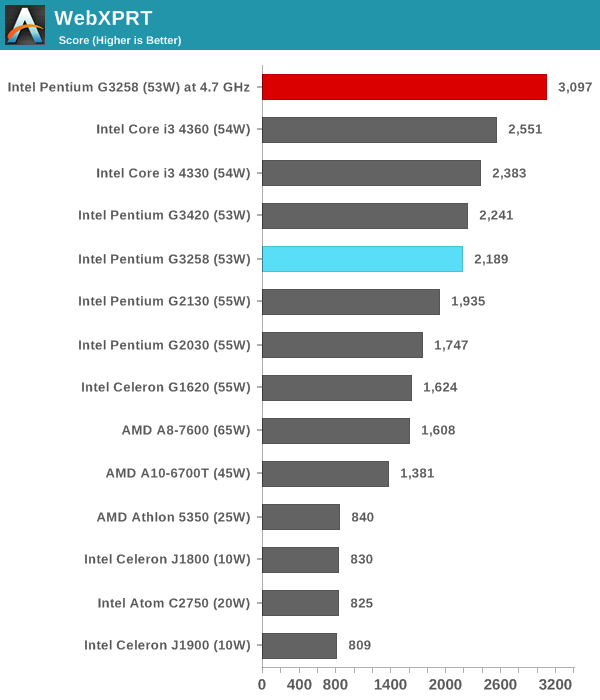
Google Octane v2
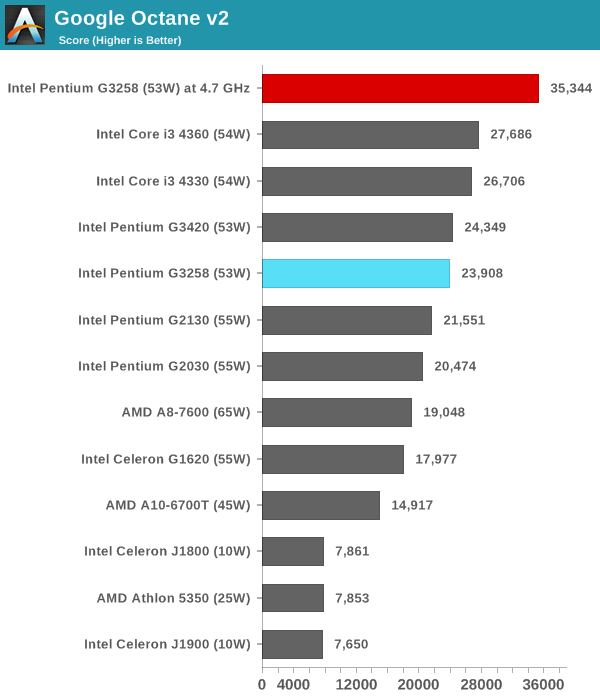
The usage model for an overclocked G3258 comes in highly single threaded environments. 4.7 GHz is nothing to be sniffed at, especially when it comes to web browsing or simple photo editing where it beats out more expensive processors. With multithreaded scenarios, it battles with the i3 depending on if the software can use hyperthreading to its full advantage. If the software can do that, then the i3 still wins out.










96 Comments
View All Comments
Computer Bottleneck - Tuesday, July 15, 2014 - link
FWIW, On my stock cooler 4.6 Ghz open-air Prime 95 stability test (in-place large FFTs, maximum power consumption) and Battlefield 3 64 player I used Speed fan 4.49 to monitor temps. However, I did notice MSI Afterburner v3.0.1 and HWiNFO64 v4.40 were recording temps 10 to 15 C higher than Speedfan 4.49.With that mentioned, I did not notice any throttling during my 4.6 Ghz stock cooler (open air environment) Prime 95 stability test. Nor did I see this during BF3 64 player gameplay.
tuxRoller - Tuesday, July 15, 2014 - link
It supports ecc ram.Hardball - Monday, July 14, 2014 - link
What type of cooling was used/is recommended in order to get a G3258 to 4.5GHz+? If you need high end air or AIO water ($80-120), it kind of runs counter to the idea of building the cheap, high performing system.Ian Cutress - Monday, July 14, 2014 - link
If you cheap on everything, then it won't ever be high performing. I used a Corsair H80i for these numbers during a nice warm British summer. The best place to start for overclocking would be a cooler with at least four copper heatpipes and a decent fan, then go from there.smunter6 - Monday, July 14, 2014 - link
Can you run power draw numbers for this system? Starting TDP for the Pentium is 53 W, I don't think it would run much above 100-150 W overclocked. Stock Intel cooler is rated for 95W, and even your cheapest aftermarket cooler should be good for much more than that.Ian Cutress - Monday, July 14, 2014 - link
System power draw numbers are in the overclocking chart, first page. You probably scrolled past them in order to comment :DWith my inefficient setup, it registered 93W at peak load at stock, moving up to 131W overclocked to 4.7 GHz.
smunter6 - Monday, July 14, 2014 - link
My bad...should have re-read. Performing some terrible math here, but if we assume 53W at stock speeds, then that's 40 W system overhead. At 131W at 4.7 GHz, approx. 93W for the CPU. On the edge for Intel's cooler, but definitely doesn't require anything that fancy to cool. An AMD A10 is around 100W TDP. And if you're willing to drop a point or two to 4.5 or 4.6 GHz, the power draw is even less.Samus - Monday, July 14, 2014 - link
The stock cooler is rated at 95w for how long? Because my experience, even going back to the i7-920, is the stock cooler can't keep a chip running at default frequency/voltage for more than a few hours at full load without throttling. Those coolers were supposedly rated at 130w, just like the CPU. But as the surface area heats up across every mm of fins and the ambient case temp jumps just a few degrees, the performance dips.Top-down coolers are a 20th century thing.
smunter6 - Monday, July 14, 2014 - link
the i7-920 is a 130W TDP part. The Pentium is 53W, and even when at max overclock, the total system power draw is only 131W. Totally different ball game.extide - Tuesday, July 15, 2014 - link
Are you kidding me? ALL stock intel CPU fans will allow the cpu they come with to run at 100% load 24/7 without throttling. If you are having problems making that happen, you are doing something wrong.